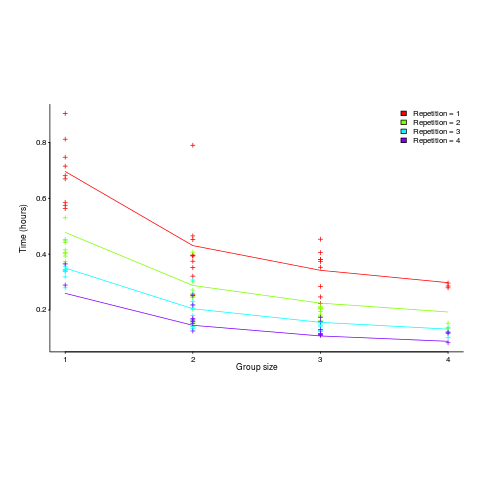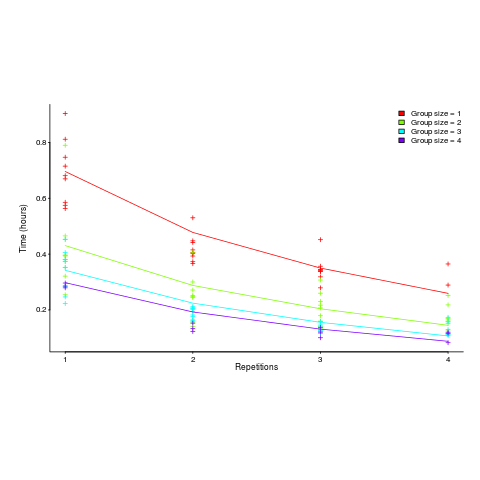Archive
Impact of group size and practice on manual performance
How performance varies with group size is an interesting question that is still an unresearched area of software engineering. The impact of learning is also an interesting question and there has been some software engineering research in this area.
I recently read a very interesting study involving both group size and learning, and Jaakko Peltokorpi kindly sent me a copy of the data.
That is the good news; the not so good news is that the experiment was not about software engineering, but the manual assembly of a contraption of the experimenters devising. Still, this experiment is an example of the impact of group size and learning (through repeating the task) on time to complete a task.
Subjects worked in groups of one to four people and repeated the task four times. Time taken to assemble a bespoke, floor standing rack with some odd-looking connections between components was measured (the image in the paper shows something that might function as a floor standing book-case, if shelves were added, apart from some component connections getting in the way).
The following equation is a very good fit to the data (code+data). There is theory explaining why  applies, but the division by group-size was found by suck-it-and-see (in another post I found that time spent planning increased with teams size).
applies, but the division by group-size was found by suck-it-and-see (in another post I found that time spent planning increased with teams size).
There is a strong repetition/group-size interaction. As the group size increases, repetition has less of an impact on improving performance.
![time = 0.16+ 0.53/{group size} - log(repetitions)*[0.1 + {0.22}/{group size}] time = 0.16+ 0.53/{group size} - log(repetitions)*[0.1 + {0.22}/{group size}]](https://shape-of-code.com/wp-content/plugins/wpmathpub/phpmathpublisher/img/math_981_b0d171bba046801a68ce5dc8ae1d6115.png)
The following plot shows one way of looking at the data (larger groups take less time, but the difference declines with practice), lines are from the fitted regression model:

and here is another (a group of two is not twice as fast as a group of one; with practice smaller groups are converging on the performance of larger groups):

Would the same kind of equation fit the results from solving a software engineering task? Hopefully somebody will run an experiment to find out 🙂
Impact of team size on planning, when sitting around a table
A recent blog post by Allan Kelly caught my attention; on Monday Allan sent me some comments on the draft of my book and I got to ask for a copy of his data (you don’t need your own software engineering data before sending me comments).
During an Agile training course he gives, Allan runs an exercise based on an extended version of the XP game. The basic points are: people form into teams, a task is announced, teams have to estimate how long it will take them to complete the task and then to plan the task implementation. Allan recorded information on team size, time spent estimating and time spent planning (no information on the tasks, which were straightforward, e.g., fold a paper airplane).
In a recent post I gave a brief analysis of team size on productivity. What does this XP game data have to say about the impact of team size on performance?
We don’t have task information, but we do have two timing measurements for each team. With a bit of suck-it-and-see analysis, I found that the following equation explained 50% of the variance (code+data):

where:  is the number of people on a team,
is the number of people on a team,  is the time in minutes the team spent estimating and
is the time in minutes the team spent estimating and  is time in minutes the team spent planning the task implementation.
is time in minutes the team spent planning the task implementation.
There was some flexibility in the numbers, depending on the method used to build the regression model.
The introduction of each new team member incurs a fixed overhead. Given that everybody is sitting together around a table, this is not surprising; or, perhaps the problem was so simply that nobody felt the need to give a personal response to everything said by everybody else; or, perhaps the exercise was run just before lunch and people were hungry.
I am not aware of any connection between time spent estimating and time spent planning, but then I know almost nothing about this kind of XP game exercise. That square-root looks interesting (an exponent of 0.4 or 0.6 was a slightly less good fit). Thoughts and experiences anybody?
Update: I forgot to mention that including the date of the workshop in the above model increases the variance explained to 90%. The date here is a proxy for the task being solved. A model that uses just the date explains 75% of the variance.
Recent Comments